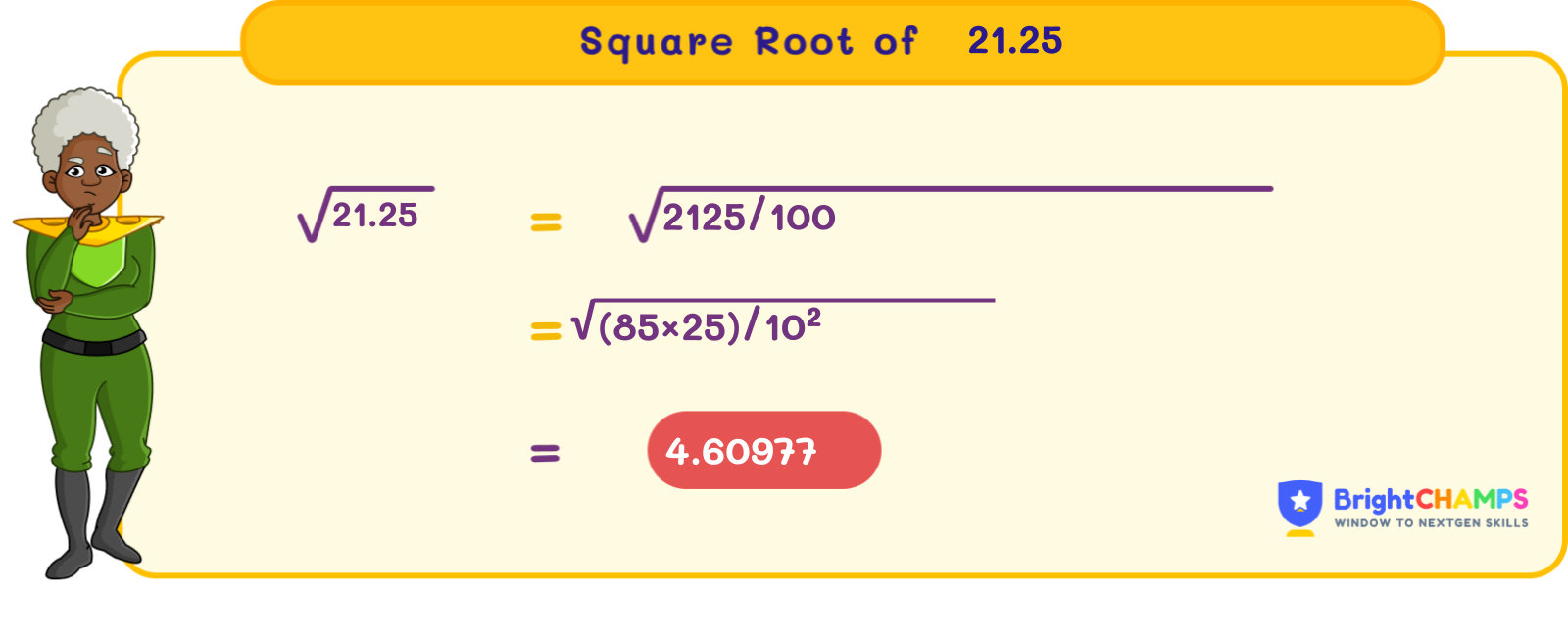![]() Table Of Contents
Table Of Contents

 101 Learners
101 LearnersLast updated on April 8th, 2025

Square Root of 21.25

If a number is multiplied by itself, the result is a square. The inverse of the square is a square root. The square root is used in many fields such as vehicle design, finance, and more. Here, we will discuss the square root of 21.25.
What is the Square Root of 21.25?
The square root is the inverse operation of squaring a number. 21.25 is not a perfect square. The square root of 21.25 is expressed in both radical and exponential form. In radical form, it is expressed as √21.25, whereas in exponential form it is expressed as (21.25)^(1/2). √21.25 ≈ 4.609772, which is an irrational number because it cannot be expressed as a fraction of two integers.
Finding the Square Root of 21.25
The prime factorization method is typically used for perfect square numbers. However, for non-perfect squares like 21.25, we use methods such as the long division method and approximation method. Let us now learn the following methods:
- Long division method
- Approximation method
Square Root of 21.25 by Long Division Method
The long division method is particularly useful for finding the square root of non-perfect square numbers. Let us learn how to find the square root of 21.25 using this method, step by step:
Step 1: Pair digits from right to left, starting with the decimal point. For 21.25, group it as 21 and 25.
Step 2: Find the largest number whose square is less than or equal to 21. This number is 4 because 4 x 4 = 16, which is less than 21.
Step 3: Subtract 16 from 21, giving a remainder of 5. Bring down 25 to make it 525.
Step 4: Double the quotient (4) to get 8, which becomes the starting digit of the new divisor.
Step 5: Find a digit X such that 8X multiplied by X gives a product less than or equal to 525. Here, 86 x 6 = 516.
Step 6: Subtract 516 from 525 to get 9. Add decimal points and bring down 00 to make it 900.
Step 7: Continue the process with the new divisor, 92, to refine the square root to desired decimal places.
The square root of 21.25 is approximately 4.609772.
Square Root of 21.25 by Approximation Method
The approximation method provides an easy way to estimate the square root of a given number. Here’s how to use it for 21.25:
Step 1: Identify the perfect squares closest to 21.25.
These are 16 (4^2) and 25 (5^2).
Therefore, √21.25 is between 4 and 5.
Step 2: Apply the formula:
(Given number - smaller perfect square) / (larger perfect square - smaller perfect square).
For 21.25, use (21.25 - 16) / (25 - 16) = 5.25 / 9 ≈ 0.5833.
Step 3: Add this value to the lower bound of the range: 4 + 0.5833 ≈ 4.5833.
So, the approximate square root of 21.25 is 4.609772.

Common Mistakes and How to Avoid Them in the Square Root of 21.25

Square Root of 21.25 Examples

Problem 1
Can you help Max find the area of a square box if its side length is given as √21.25?

Explanation

Problem 2
A square-shaped garden measures 21.25 square feet; if each side is √21.25, what will be the area of half of the garden?

Explanation

Problem 3
Calculate √21.25 x 5.

Explanation

Problem 4
What will be the square root of (18 + 3.25)?

Explanation

Problem 5
Find the perimeter of a rectangle if its length 'l' is √21.25 units and the width 'w' is 10 units.

Explanation


FAQ on Square Root of 21.25
1.What is √21.25 in its simplest form?
2.What are the factors of 21.25?
3.Calculate the square of 21.25.
4.Is 21.25 a prime number?
5.21.25 is divisible by?
Important Glossaries for the Square Root of 21.25
- Square root: The square root of a number is a value that, when multiplied by itself, gives the original number. For example, √16 = 4.
- Irrational number: A number that cannot be written as a simple fraction; its decimal goes on forever without repeating. Example: √21.25 is irrational.
- Approximation method: A technique for estimating the value of a square root by comparing it to nearby perfect squares.
- Long division method: A systematic approach to find the exact square root of a non-perfect square number through division.
- Decimal: A number that includes a whole number and a fraction expressed with a dot. For example, 4.609772 is a decimal.
Explore More algebra
 Previous to Square Root of 21.25
Previous to Square Root of 21.25


Jaskaran Singh Saluja
About the Author
Jaskaran Singh Saluja is a math wizard with nearly three years of experience as a math teacher. His expertise is in algebra, so he can make algebra classes interesting by turning tricky equations into simple puzzles.

Fun Fact
: He loves to play the quiz with kids through algebra to make kids love it.




